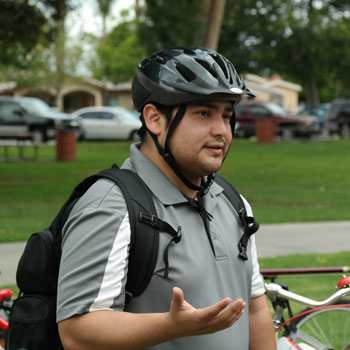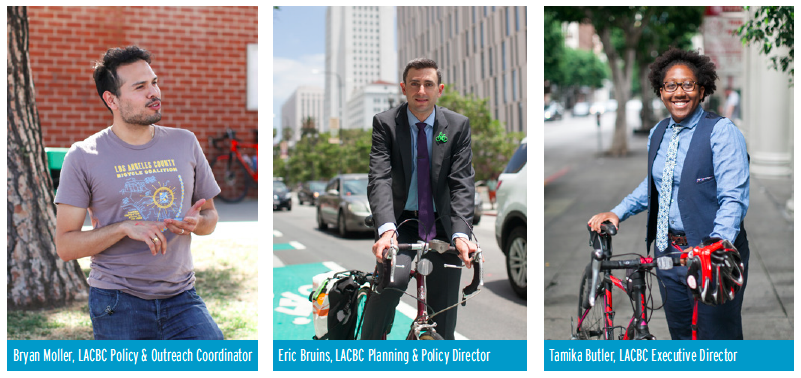DISCOVER YOUR LOCAL BICYCLING COMMUNITY
Find local advocacy groups, bike shops, instructors, clubs, classes and more!
Beyond City Limits: LACBC’s Regional Approach to Equity
This story first appeared in the Fall 2015 issue of the League’s magazine, American Bicyclist.
 Like many young boys, Baru Sanchez (pictured right) wanted to be like his big brother. Growing up, Sanchez watched his sibling catch air on his BMX bike, doing tricks that made Sanchez aspire to ride, too. When he was 12 years old, Sanchez’s family moved to the City of Cudahy, a small but dense community of 24,000 people in southeast Los Angeles County. Again, like so many young boys, he explored his new neighborhood on his bike, until he entered high school.
Like many young boys, Baru Sanchez (pictured right) wanted to be like his big brother. Growing up, Sanchez watched his sibling catch air on his BMX bike, doing tricks that made Sanchez aspire to ride, too. When he was 12 years old, Sanchez’s family moved to the City of Cudahy, a small but dense community of 24,000 people in southeast Los Angeles County. Again, like so many young boys, he explored his new neighborhood on his bike, until he entered high school.
Now, more than a decade later, Baru Sanchez is back on two wheels — and he’s the one hoping to inspire and empower others to get out and ride in a city that’s been overlooked for cycling infrastructure and undermined by government corruption.
Sanchez isn’t one to sidestep a challenge. He’s the third of five children, the first to graduate high school and, after getting a college degree, worked his way up to senior auditor at an area accounting firm. In 2013, when he was just 25 years old, he pledged to put those skills to work for his city, which was rebuilding after an FBI bribery sting that brought down the city’s former mayor, a councilman and the director of code enforcement.
In Cudahy, more than 90 percent of the population is Latino and 30 percent live below the poverty line. In addition to rent-controlled housing and accountable government, one way Sanchez wants to uplift his community is through better biking. And he’s working with the Los Angeles County Bicycle Coalition to authentically engage his fellow residents in that effort.
Like Sanchez, the LACBC seeks to serve the residents of Cudahy. With a mission that extends beyond the City of Los Angeles, LACBC’s constituents are the more than 9 million people who live in the 88 incorporated municipalities that make up the entire county. Many of those cities are dense, diverse and full of folks who bike and walk. But especially in the southeast areas of the county, many of those communities — like Cudahy — don’t have safe infrastructure for active transportation.

LACBC staff photos by Serena Grace
Why? According to Eric Bruins, LACBC’s Planning and Policy Director, it comes down to planning — and the resources to do it. “One of the main things we’ve discovered is that there’s so little planning done at the regional level and there are real gaps in LA County,” he says. “Only one-third of the cities have bike plans — the well-resourced cities. The lower-resourced cities are not doing the planning to plug into the region as to what their needs are… So we’ve developed partnerships that are really geared toward capacity-building to provide resources to local cities to make them more competitive for state programs.”
In 2014, the LACBC got a “Big Ideas” grant from Advocacy Advance — a partnership of the League and the Alliance for Biking & Walking — to support this critical work. Their goal: To create active transportation master plans for five cities in the southeast Los Angeles County area (Bell, Bell Gardens, Commerce, Cudahy, Vernon) so they’d be eligible and competitive for infrastructure and programmatic grants.
That funding leveraged additional dollars from the Annenberg Foundation, which paid for a grant writer. But LACBC knew they couldn’t build a bicycle-friendly future from the confines of a city hall conference room. They needed to get the community involved.
Bryan Moller knows those communities well; the LACBC’s Policy and Outreach Coordinator grew up biking and skateboarding in Bell. Over the course of several months in early 2015, Moller helped to organize a series of community bike rides that partnered with local organizations in the target cities, including the LA River Revitalization Corporation and East Yard Communities for Environmental Justice. They distributed fliers in Spanish and English, inviting residents to ride and share what would improve their experiences bike, walking and taking transit.
Las ciudades de Bell, Bell Gardens, Commerce, Cudahy, Maywood y Vernon quieren saber su opinion sobre como hacer mas facil y mas seguro andar en bici, ser peaton, y como majorar el acceso al transporte publico. Unase a nosotros en estos paseos para explorar su comunidad y aprender como partcipar.
The cities of Bell, Bell Garden, Commerce, Cudahy, Maywood and Vernon want to hear from you on how to make it easier and safer for you to walk, bike and access transit. Join us on these rides to explore your community and learn how to get involved.
During the rides, participants discussed key questions like, how can we improve access to the Los Angeles River from our communities and close the gap to downtown LA? How can walking and biking support our bigger goals of creating a healthier, safer and more livable southeast region? How can biking and walking connect people and places that make our neighborhoods unique. That input was also gathered through a two-page survey, also conducted in Spanish and English. “It was really robust outreach,” Moller says.
Ride in Cudahy
And even Moller was somewhat surprised by the response. “In Latino culture, it’s not necessarily positive that you take the bus or you bike places,” he says. “There’s the perception that people bike because they have no other means. But everyone was really into it. These cities have some of the highest walking, biking and transit commuting numbers in LA County, so it was super exciting that this could really set the tone for a region-wide conversation.”
Sanchez was eager to play a leadership role. Having attended California State University, Long Beach, he saw the impact the bike lanes in that Bronze Bicycle Friendly Community had on the community — and local businesses. He saw cycling as not only a means for his residents to get out of Cudahy to access services across the region, but also to celebrate and elevate the strengths within his community. And he recognized the importance of involving residents before the paint hit the pavement.
“We started doing a monthly ride to get awareness out there that the city was applying for grants for bike lanes and Safe Routes to School, so we were building that bicycle community now rather than later — so we have that community ready to use those bike lanes,” he says.
One thing that became clear to Sanchez from the community rides is that residents of Cudahy don’t just want a means to get from point A to point B. Parents want to enjoy open spaces with their children, he says. Families want to spend time together doing healthy activities, like biking. That broad-spectrum of potential riders not only made it easier to find allies among his colleague within the City of Cudahy, but also inspired Sanchez to think about even bigger collaborations. He’s reached out to elected officials in neighboring municipalities, developing a coalition of southeast leaders.
“It’s small cities thinking big,” he says.
Tamika Butler, LACBC’s Executive Director, says collaborating with leaders like Sanchez has inspired them to think bigger — and more intentionally — about the scope of their work as an organization, as well. “For me, it’s part of the reason equity has become such a clear front runner as one of our principles,” she says. “Our work in the Southeast Cities is on the forefront of that in bike advocacy.” And Sanchez has been leading that pack.
“The community engagement is genuine and being led by elected officials from and with the community. That really brings authenticity on each of these rides. Members of the community are there, they’re talking about what’s happening and what’s not happening and feel like they’re being listened to.” – Tamika Butler
“Councilmember Sanchez has been a shining example of not only talking the talk, but riding the ride and really being there with us,” she says. “I think the elected officials vested in this are all about community pride and community improvement. What’s been really impressive here is the community engagement is genuine and being led by elected officials from and with the community. That really brings authenticity on each of these rides. Members of the community are there, they’re talking about what’s happening and what’s not happening and feel like they’re being listened to.”
“That community engagement impacts our ability to think regionally,” she continues. “Sometimes, for policy’s sake, people want issues to end at the city limits. But that’s what’s great about these rides; during the course of the ride you’re very rarely in just one city.”
The course of LACBC’s work in the Southeast Cities, Bruins points out, has really just begun. A key lesson learned for other advocates: Especially when you’re building trust in a new community, it takes time, energy and resources to do this work.
“We haven’t cracked the code on outreach and engagement,” Bruins says, “but we’ve got a good start. Now we’re building deeper relationships with partners and local elected officials to establish a more regular presence in the community moving forward. The funding that we got from Advocacy Advance allowed us to dip our toe in. It’s going to take a lot more resources to sustain it and build long-term capacity in the region.”
Sanchez, for one, is in it for the long term. “I’ve been to Amsterdam and I’m not saying Cudahy is going to be there soon,” he says, with a laugh, “but I do foresee a future with more bicycling.”
Read more about LACBC at www.la-bike.org.